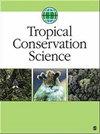Genetic and Ecological Divergence of Cinnamon Hummingbird Amazilia rutila (Aves: Trochilidae) Continental Populations Separated by Geographical and Environmental Barriers
IF 1.6
4区 环境科学与生态学
Q2 BIODIVERSITY CONSERVATION
引用次数: 0
Abstract
Background and Research Aims: Historical geological events and climatic changes have played important roles in shaping population differentiation and distribution within species. Amazilia rutila (Trochilidae) is a widespread hummingbird species in the tropical dry forest along the Pacific slope and the Yucatán Peninsula in Mexico. Methods: We used mitochondrial DNA sequence, ecological niche modelling and niche divergence tests to determine the effects of major geographic barriers and environmental variability on genetic and niche divergence of A. rutila continental populations. Results: Our results revealed three genetic groups without haplotype sharing corresponding to the distribution of individuals/populations from the Pacific slope W of the Isthmus of Tehuantepec (PAC), in Oaxaca and Chiapas E of the Isthmus of Tehuantepec (CHIS_OAX) and those from the Yucatán Peninsula and Guatemala (YUC). Values of neutrality tests suggest past demographic expansion without effective population size changes over time, and the time since the demographic expansion ranged between 39.4 and 84.45 ka BP. Each genetic group differed in their position in environmental space, with low-to-very limited overlap in the fundamental climatic niche dimensions of all groups analyzed, particularly between YUC and PAC. Analysis of climate differentiation and ecological niche comparisons showed that the environmental space occupied by these mtDNA groups is similar but not identical. Conclusion: We conclude that the genetic differentiation of A. rutila is consistent with a model of population isolation by geographical barriers and environmental differences. Inferences about the consequences of past demographic expansion and isolation underlying intraspecific evolutionary relationships await further study. Implications for Conservation: Our findings highlight the importance of preserving evolutionary significant units of this widespread hummingbird species. Conservation actions must consider intrinsic requirements of evolutionarily distinct populations and the environmental drivers that shape their distributions, maximizing preservation of intraspecific genetic variability and monitoring changes in genetic diversity.被地理和环境屏障隔离的肉桂蜂鸟(鸟科)大陆种群的遗传和生态分化
背景与研究目的:历史地质事件和气候变化对种群的分化和分布具有重要影响。牛皮Amazilia rutila(牛皮Amazilia rutila)是一种分布广泛的蜂鸟,分布在沿太平洋斜坡和墨西哥Yucatán半岛的热带干燥森林中。方法:采用线粒体DNA序列、生态位建模和生态位分化测试等方法,研究主要地理屏障和环境变异对芦丁大陆居群遗传和生态位分化的影响。结果:发现了三个单倍型不共享的遗传群,分别来自特万特佩克地峡太平洋坡W (PAC)、瓦哈卡和恰帕斯E (CHIS_OAX)和Yucatán半岛和危地马拉(YUC)的个体/群体分布。中性检验的值表明,过去的人口扩张没有随着时间的推移而发生有效人口规模的变化,自人口扩张以来的时间在39.4 ~ 84.45 ka BP之间。各遗传类群在环境空间中的位置不同,各遗传类群的基本气候生态位维度重叠程度低至非常有限,尤以YUC和PAC为甚。气候分异分析和生态生态位比较表明,这些mtDNA类群所占据的环境空间相似但不相同。结论:红豆杉的遗传分化符合地理屏障和环境差异导致的种群隔离模式。关于过去的人口扩张和种内进化关系背后的隔离的后果的推论有待进一步研究。对保护的启示:我们的发现强调了保护这种广泛分布的蜂鸟物种的进化重要单位的重要性。保护行动必须考虑进化上不同种群的内在需求和塑造其分布的环境驱动因素,最大限度地保护种内遗传变异并监测遗传多样性的变化。
本文章由计算机程序翻译,如有差异,请以英文原文为准。
求助全文
约1分钟内获得全文
求助全文
来源期刊

Tropical Conservation Science
BIODIVERSITY CONSERVATION-
CiteScore
3.60
自引率
5.90%
发文量
16
审稿时长
>12 weeks
期刊介绍:
Tropical Conservation Science is a peer-reviewed, open access journal that publishes original research papers and state-of-the-art reviews of broad interest to the field of conservation of tropical forests and of other tropical ecosystems.
 求助内容:
求助内容: 应助结果提醒方式:
应助结果提醒方式:


